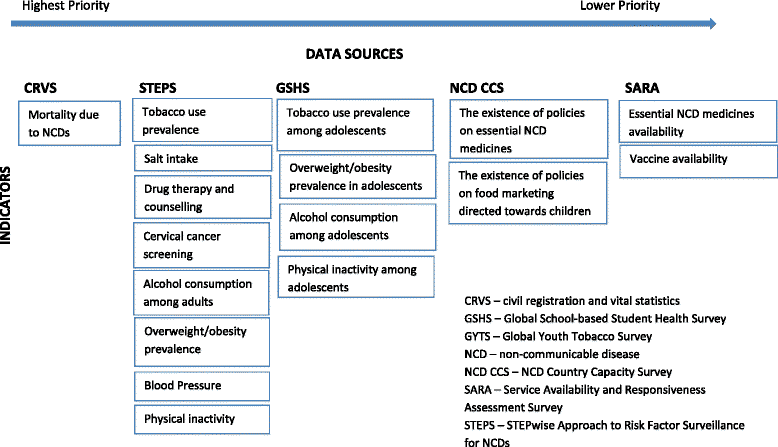Health information priorities for more effective implementation and monitoring of non-communicable disease programs in low- and middle-income countries: lessons from the Pacific
- PMID: 26391337
- PMCID: PMC4578613
- DOI: 10.1186/s12916-015-0482-5
Health information priorities for more effective implementation and monitoring of non-communicable disease programs in low- and middle-income countries: lessons from the Pacific
Erratum in
-
Erratum to: Health information priorities for more effective implementation and monitoring of non-communicable disease programs in low- and middle-income countries: lessons from the Pacific.BMC Med. 2015 Oct 20;13:272. doi: 10.1186/s12916-015-0506-1. BMC Med. 2015. PMID: 26486593 Free PMC article. No abstract available.
Abstract
Background: Non-communicable diseases (NCDs) place enormous burdens on individuals and health systems. While there has been significant global progress to guide the development of national NCD monitoring programs, many countries still struggle to adequately establish critical information systems to prioritise NCD control approaches.
Discussion: In this paper, we use the recent experience of the Pacific as a case study to highlight four key lessons about prioritising strategies for health information system development for monitoring NCDs: first, NCD interventions must be chosen strategically, taking into account local disease burden and capacities; second, NCD monitoring efforts must align with those interventions so as to be capable of evaluating progress; third, in order to ensure efficiency and sustainability, NCD monitoring strategies must be integrated into existing health information systems; finally, countries should monitor the implementation of key policies to control food and tobacco industries. Prioritising NCD interventions to suit local needs is critical and should be accompanied by careful consideration of the most appropriate and feasible monitoring strategies to track and evaluate progress.
Figures
Similar articles
-
Monitoring and accountability for the Pacific response to the non-communicable diseases crisis.BMC Public Health. 2016 Sep 10;16(1):958. doi: 10.1186/s12889-016-3614-8. BMC Public Health. 2016. PMID: 27613495 Free PMC article.
-
Trends in premature avertable mortality from non-communicable diseases for 195 countries and territories, 1990-2017: a population-based study.Lancet Glob Health. 2020 Apr;8(4):e511-e523. doi: 10.1016/S2214-109X(20)30035-8. Lancet Glob Health. 2020. PMID: 32199120
-
NCD Countdown 2030: worldwide trends in non-communicable disease mortality and progress towards Sustainable Development Goal target 3.4.Lancet. 2018 Sep 22;392(10152):1072-1088. doi: 10.1016/S0140-6736(18)31992-5. Epub 2018 Sep 20. Lancet. 2018. PMID: 30264707
-
Mitigating the Rising Burden of Non-Communicable Diseases through Locally Generated Evidence-Lessons from Tanzania.Ann Glob Health. 2023 Nov 17;89(1):77. doi: 10.5334/aogh.4111. eCollection 2023. Ann Glob Health. 2023. PMID: 38025921 Free PMC article. Review.
-
Tuberculosis.In: Holmes KK, Bertozzi S, Bloom BR, Jha P, editors. Major Infectious Diseases. 3rd edition. Washington (DC): The International Bank for Reconstruction and Development / The World Bank; 2017 Nov 3. Chapter 11. In: Holmes KK, Bertozzi S, Bloom BR, Jha P, editors. Major Infectious Diseases. 3rd edition. Washington (DC): The International Bank for Reconstruction and Development / The World Bank; 2017 Nov 3. Chapter 11. PMID: 30212088 Free Books & Documents. Review.
Cited by
-
COVID-19 and non-communicable diseases in the Eastern Mediterranean Region: the need for a syndemics approach to data reporting and healthcare delivery.BMJ Glob Health. 2021 Jun;6(6):e006189. doi: 10.1136/bmjgh-2021-006189. BMJ Glob Health. 2021. PMID: 34103327 Free PMC article. No abstract available.
-
Erratum to: Health information priorities for more effective implementation and monitoring of non-communicable disease programs in low- and middle-income countries: lessons from the Pacific.BMC Med. 2015 Oct 20;13:272. doi: 10.1186/s12916-015-0506-1. BMC Med. 2015. PMID: 26486593 Free PMC article. No abstract available.
-
Validating the self-reported annual monitoring grid for the 2007 Caribbean Community Declaration of Port-of-Spain on noncommunicable diseases.Rev Panam Salud Publica. 2018 Dec 17;42:e189. doi: 10.26633/RPSP.2018.189. eCollection 2018. Rev Panam Salud Publica. 2018. PMID: 31093216 Free PMC article.
-
Experiences of communities with Lebanon's model of care for non-communicable diseases: a cross-sectional household survey from Greater Beirut.BMJ Open. 2023 Sep 4;13(9):e070580. doi: 10.1136/bmjopen-2022-070580. BMJ Open. 2023. PMID: 37666549 Free PMC article.
-
A self-reported measurement scale on a potential component of competency in the healthcare staff engaged in the prevention and control of non-communicable disease in Fiji.BMC Health Serv Res. 2019 Nov 14;19(1):838. doi: 10.1186/s12913-019-4695-8. BMC Health Serv Res. 2019. PMID: 31727066 Free PMC article.
References
-
- United Nations . Political declaration of the high-level meeting of the General Assembly on the prevention and control of NCDs. New York: United Nations; 2011.
-
- United Nations . Outcome document of the high-level meeting of the General Assembly on the comprehensive review and assessment of the progress achieved in the prevention and control of non-communicable diseases. New York: United Nations; 2014.
-
- Phillips DE, AbouZahr C, Lopez AD, Mikkelsen L, de Savigny D, Lozano R, et al. Are well functioning civil registration and vital statistics systems associated with better health outcomes? Lancet. 2015. Ahead of print. doi:10.1016/S0140-6736(15)60172-6. - PubMed
-
- AbouZahr C, de Savigny D, Mikkelsen L, Setel PW, Lozano R, Lopez AD. Towards universal civil registration and vital statistics systems: the time is now. Lancet. 2015. Ahead of print. doi:10.1016/S0140-6736(15)60170-2. - PubMed
Publication types
Grants and funding
LinkOut - more resources
Full Text Sources
Other Literature Sources


